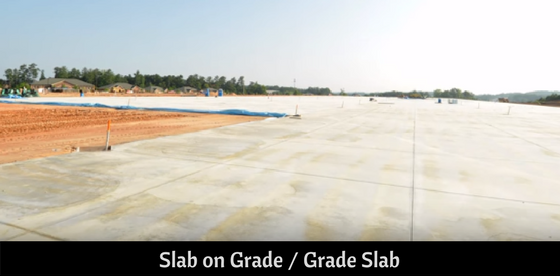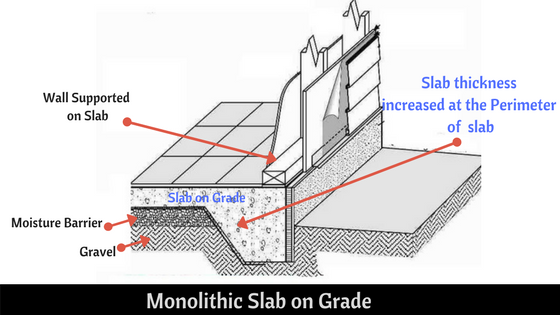In this article, you are going to learn about Slab on grade. As we already discussed about 16 different types of slabs which we usually used in construction. If you want to know? You can refer Here.
Well, Slab on grade or Grade slab is one of the 16 types of slabs. Let’s begin,
Contents
Slab on Grade:
Slabs which are directly laid on the earth, to support walls and other structural elements are called as Slab on grade or Grade Slabs.
This type of slab is casted directly on ground level. Grade slab itself acts as a foundation for the building which does not require further footings.

Grade slabs are framed in areas where the ground doesn’t freeze. This type of slabs may or may not have reinforcement in it. The decision of inserting reinforcement is based upon the floor loads and local building codes. The thickness of Grade Slab is kept minimum 4 inches. If there are concerns regarding soil characteristics like porosity, the thickness of the slab is further increased. And for safety, a layer of gravel & bitumen are laid on earth before laying concrete slab to prevent the entry of moisture content into the slab.
Different types of Slab on Grade:
There are two different types of Grade slabs
1. Supported Slab on Grade
2. Monolithic Slab on Grade
Supported Slab on Grade / Grade Slab:
Supported grade slab or slab on grade foundation is chosen when the traditional footings are already framed on site to raise the columns. From the below fig, it is clear that the wall stands on a footing and The grade slab is resting on a layer of gravel and moisture barrier. The formwork used for plinth beams are acted as batter boards for slab mould. An expansion joint is provided between concrete slab and wall to relieve the stress during high-temperature days. Control joints are laid out in a planned grid using chalk lines, these joints help to control random cracking on the slab.

Monolithic Slab on grade:
Monolithic Grade slab doesn’t have any footings, the concrete slab itself acts as a footing for the building; and columns, walls are raised from the grade slab. This type of slab is framed by providing batter boards around the slab as per plan and pouring the concrete inside batter boards. These batter boards act as a mould to identify the slab corners.
Grade slabs are usually rests on the layers of gravel and moisture barrier. Addition of these layers helps in preventing entry of water into the slab and forming surface cracks.
The perimeter of the Grade slab is thicker than the rest of surface, this thicker section acts as a mini footing and helps to distribute top loads more evenly across the surrounding soil.

Construction of Concrete Slab on grade:
Before casting slab on grade, the earth is excavated up to the required depth and compacted to expel air voids. Batters are marked and placed in position as per plan before concrete pour. These boards act as a concrete mould, which helps in identifying slab corners.
And then, soil investigation is done to design the thickness of the slab. As per results, the further layers of gravel and moisture barriers (bitumen) is poured on the ground. These layers act as a sub-base for slab and prevent the entry of moisture penetration into the slab.
The concrete is poured thicker at the edges forming like an integral footing and reinforcement rods are provided to strengthen the edges.
To minimize random cracking on the surface, the concrete is allowed to cure and dry for several days.
The expansion joint is must be provided between wall and slab. The control joints on the slab are marked using chalk lines before pouring which helps in controlling random cracking.
Difference between ordinary concrete slabs and concrete slab on grade:
| Grade on Slab | Ordinary Concrete Slab |
|---|---|
| Reinforcement may or may not be provided | Reinforcement must be provided |
| Doesn't requires footings to support | Slab is supported on columns |
| It doesn't require scaffolding to construct | Requires proper scaffolding |
| Minimal usage of formwork. Batter boards are used at corners of slab | It requires props and supports to cast. |
| The thickness of slab is increased at the edges of slab. (perimeter) | Ordinary slab has uniform thickness |
| Expansion joints are provided at the edges of slab. | Expansion joints are not required |
| Rests on earth and it doesn't requires beams to support | Rests on floor beams |
Grade on Slab Construction Procedure video:
Hope you are clear with Grade of Slab. Do share with your friends if you found this article useful.
Related Articles:
Different types of concrete Slabs
How to find the volume of concrete for slab, footings, columns.
Curing of concrete and Curing methods
For Instant updates Join our Whatsapp Broadcast. Save our Whatsapp contact +91-9700078271 as Civilread and Send us a message “JOIN“
Never Miss an update Click on “Allow US” and make us allow or Click on Red notification bell at bottom right and allow notifications. Stay tuned! More are updated Soon!!.
Civil Read Wishes you ALL the BEST for your future..
Share With Your Friends| Sharing Is Caring:)


You are doing gr8 work …..If possible please give some information regarding works done in site… which we cannot find in books.
great article. Superb
Hi,
Can we propose a slab fold / sunken slab in a grade on slab?